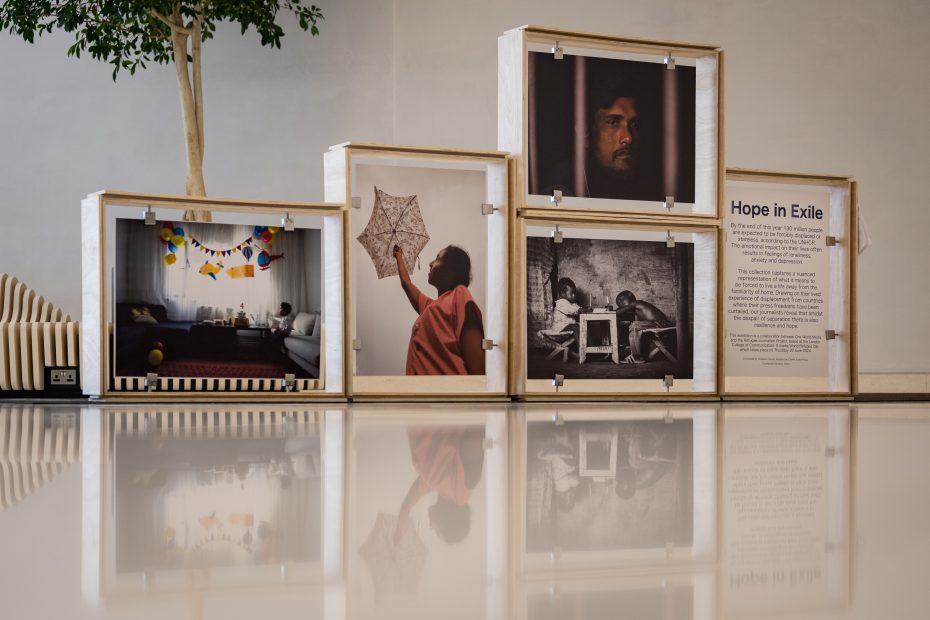Marking World Refugee Day on 20 June, “Hope in Exile,” is a photojournalism exhibition delivered by the Refugee Journalism Project and One World Media that sheds light on the experiences of forcibly displaced individuals.
By the end of this year 130 million people are expected to be forcibly displaced or stateless, according to the UN Refugee Agency. The emotional impact on their lives often results in feelings of loneliness, anxiety, and depression.
The collection of works from eight photojournalists captures a nuanced representation of what it means to be forced to live away from the familiarity of home. Drawing on their lived experiences of displacement from countries where press freedoms have been curtailed, these journalists reveal that amidst the despair of separation, there is also resilience and hope.
M.O. Raiya
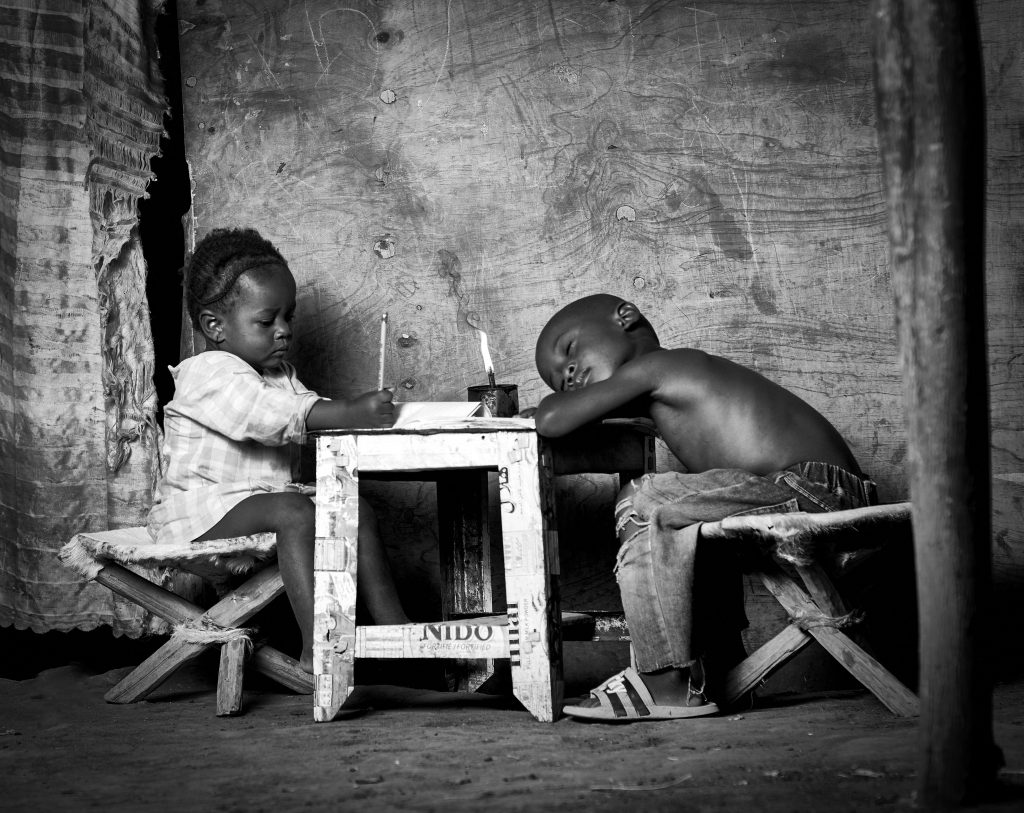
Kakuma Refugee Camp, a bustling community of 250,000 asylum seekers and refugees from various backgrounds reside. Among them are Ugandans, South Sudanese, Burundians, Congolese, Rwandese, Somalis, Yemenis, and Ethiopians. However, life in the camp presents numerous challenges. For women and girls, exploitation is rampant. Cultural norms often force young girls to abandon their education to care for family, to do chores or work for income, while their male counterparts attend school. Boys are prioritised in terms of education compared to girls, so I took this pictures to show that all girls have a right to education.
M.O. Raiya is a refugee based in Kakuma Refugee Camp. For the past eight years, he has dedicated his life to pursuing his passion for photography and film. Currently, he is a multimedia student with Film Aid Kakuma. Living in Kakuma Refugee Camp presents numerous challenges, including culture shock, poor living conditions, language barriers, and limited opportunities. However, photography has provided him with an avenue to keep himself occupied, spending time doing what he loves, and supporting his young family.
Al-Tayeb Musa
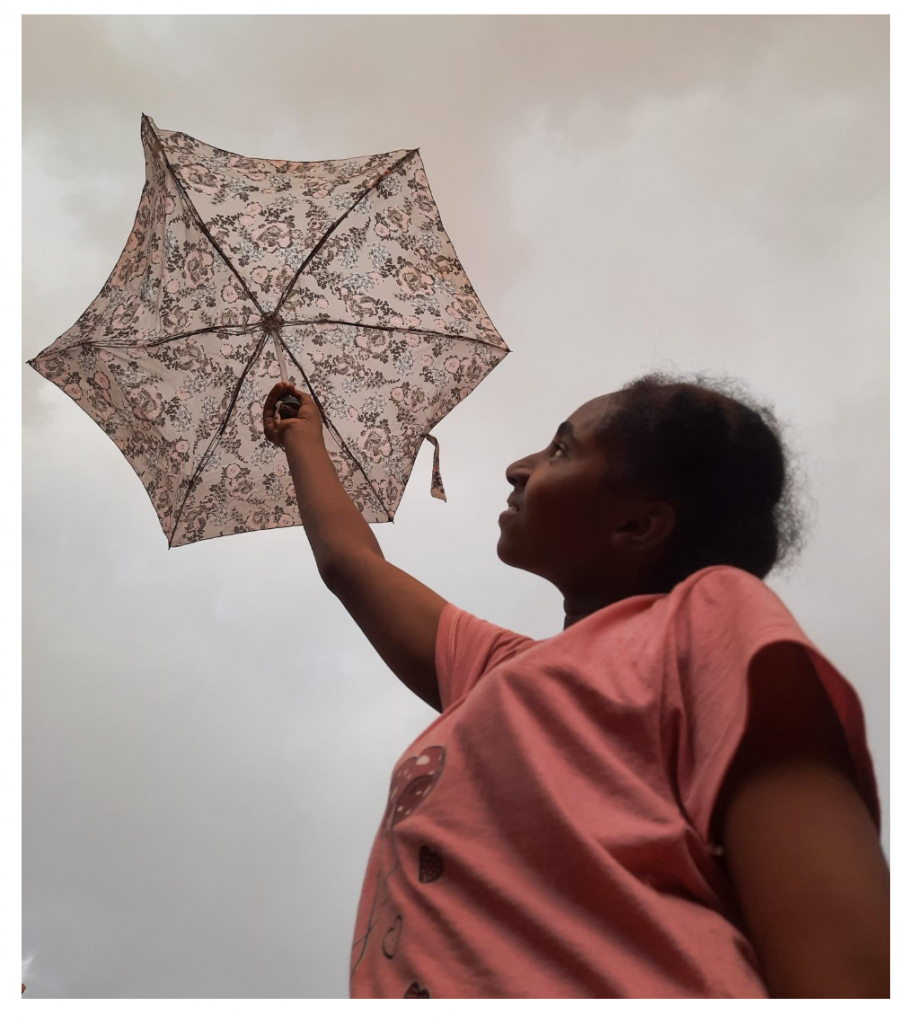
As the sound of gunfire drew nearer every minute, my attention was focused on my mother, who was in the midst of the tense atmosphere, encouraging my younger sister. Unable to reach her friend due to the war, my mother provided solace to her by observing the clouds, predicting the rain, and playing with her umbrella. Despite the frailty of our dwelling, with the Pergola and zinc-roofed rooms unable to protect us from the dangers outside, the unwavering strength of my mother, her courage, and her belief in a better tomorrow, all contributed to reassuring us. Her optimism became our calming light, affirming that as long as we remained together, we would be safe. During this poignant moment, I felt compelled to capture images of my resilient sister’s spirit, as she joyfully played with her umbrella, seemingly unperturbed by the sounds coming from the vicinity.
Al-Tayeb Musa is an independent Sudanese documentary photographer. She started working in the field of photography in 2020, during one of her artistic trips to the Nuba Mountains in South Kordofan, to cover the Kembla Cultural Festival. She also worked to document the revolutionary movement in Sudan from 2021 to 2023, She emphasized the pivotal roles played by women and youth, the challenges confronting protest processions from authorities, the involvement of street children in revolutionary activities, and the movement’s impact on small-scale professionals. She departed Sudan on June 6, 2023, amidst the escalating conflict that spilled across the country, escaping through the Ethiopian border, seeking refuge from the life-threatening turmoil plaguing my homeland.
Lara Aburamada
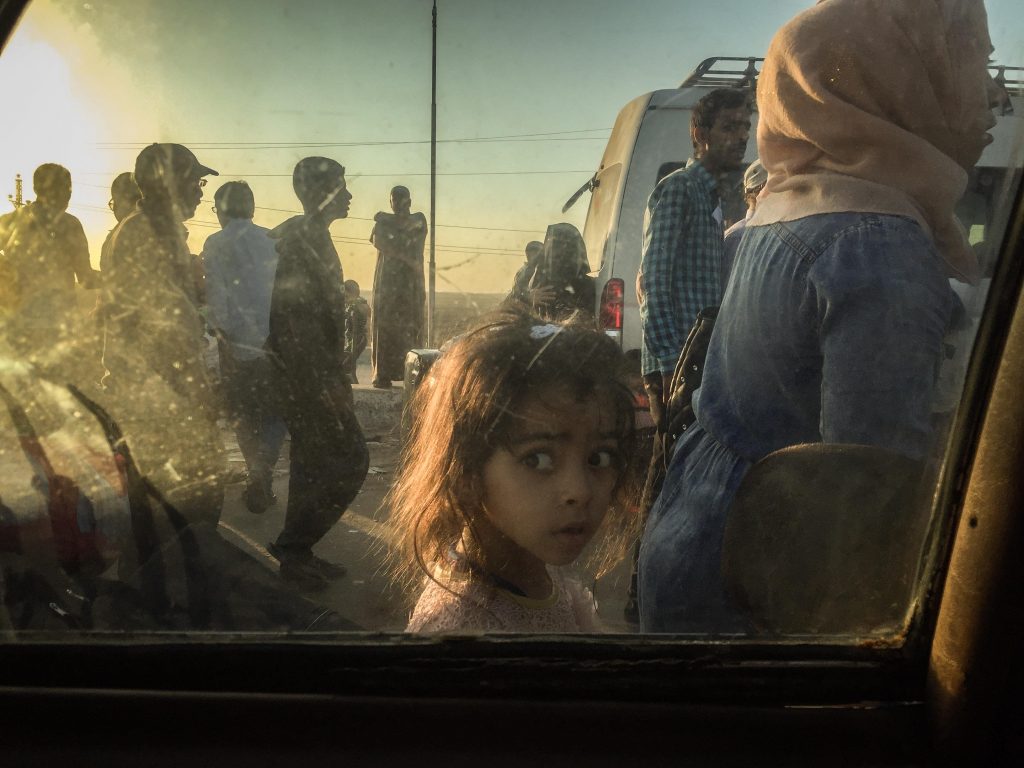
“Leaving Home”, A girl walks with her mother to take a taxi to Egypt after the curfew in Sinai ended at 6 AM at Rafah border crossing with Gaza Strip. There were hundreds of us, families, students, young and elderly people sleeping on the floors at the Egyptian borders, waiting for our names to be called to be allowed to cross into Egypt. Thousands of people are desperate to leave the Gaza Strip due to the ongoing blockade that prevents them from freedom of movement and the lack of basic human needs like water, health rights, and more. Rafah Crossing opens only for a few days every few months, and sometimes, it can reach a year, and not everyone can leave. On that day, I was able to leave my home in Gaza and start over as a refugee in the US in October, 2016.
Lara Aburamadan is a Palestinian visual artist, journalist, and founder of Refugee Eye. Born and raised in Gaza City, now based in the San Francisco Bay Area, she tends to embrace the human perspective through visual storytelling. Her photographs and writings have been published in Time Magazine, New York Times, VICE, The Atlantic, NPR, San Francisco Chronicle, The Progressive Magazine, AJ+, and elsewhere. Lara has been chosen by Time Magazine among 34 women photojournalists around the world that you should follow their work in 2017.
Maryam Ashraf

Following the death of Jina (Mahsa) Amini, hundreds of people marched on the streets of San Francisco to show solidarity with the protesters in Iran and condemn the government’s violent response to it. While some were shouting her name and slogans in solidarity with the Iranians, some women cut their hair, an act which became symbolic during the protest both in Iran and outside and amongst those who wish to show their solidarity and support for the Iranian people. Holding a photo of Jina in one hand and part of her hair in another hand, the young protester shouts her name in anger and seeks justice for her death.
Maryam Ashrafi is a Paris-based Iranian photographer. Born in Tehran during the Iran and Iraq war, Maryam is passionate about sociology which led her to focus her interest on social and political issues. For several years, she worked on different subjects in Paris: from the mobilisation of the Kurdish and Iranian diasporas to riots following various social and political issues. Above all, as an independent freelance photographer who believes in long-term projects, she has covered the aftermath of wars from Kobane in Northern Syria to Sinjar in Iraqi Kurdistan from 2012 to 2018. Her work on Kurdish resistance movements has been the subject of several exhibitions and publications. Her first book “Rising among ruins, Dancing amid bullets”, which has won the PrixHip and Lucie Photo Book prize documents the consequences of war and the lives of civilians returning to their homes in Northern Syria and the autonomous Kurdistan region of Northern Iraq. Her long-term work on Kurdish issues has also driven her to work as a camerawoman in documentaries such as “I Am The Revolution” and her first documentary film; “Eternal Sentinel”, was released in early 2022 and has been selected for the FIGRA and PriMed festival in France as well as the Warm Festival in Sarajevo and has been screened at the Frontline club in London and Stanford University in the U.S.
Masrat Zahra
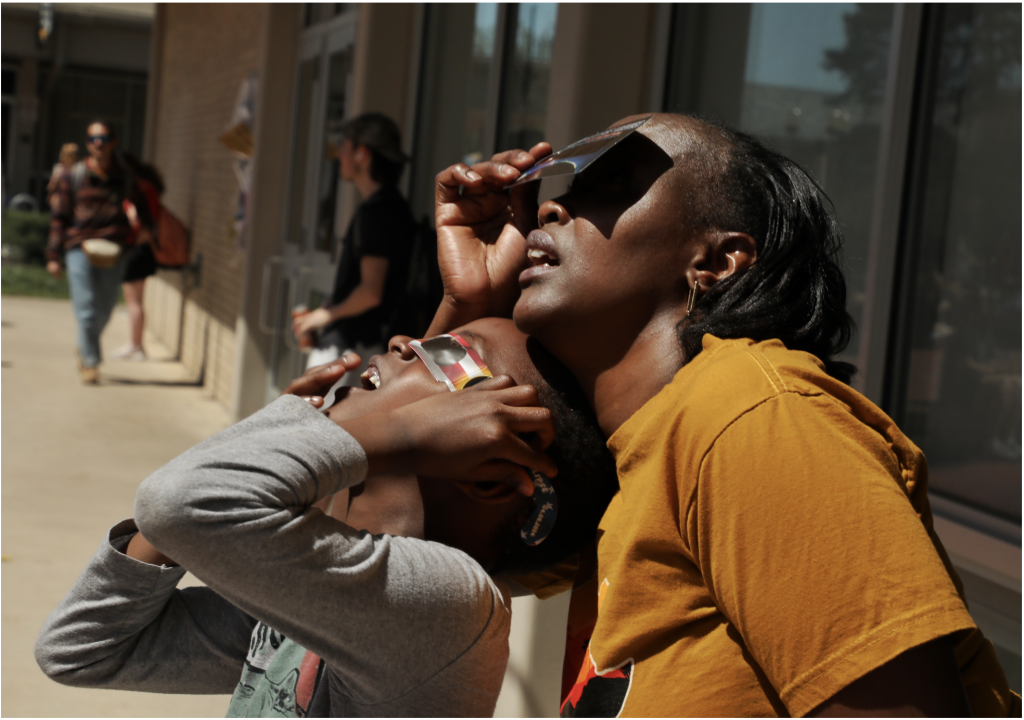
This photo means the world to me—it’s like a piece of my heart captured in pixels. After years of silence behind the lens, it was the first click of my camera in exile, and it holds all the emotions of that moment. Watching a mother and her son, their faces lit up by a solar eclipse, filled me with a mix of emotions. It was like a mirror reflecting my own yearning for connection and belonging. Their embrace spoke volumes—it was a reminder of the love and warmth I’ve been missing. For a brief moment, I could almost feel the hug of my own family, thousands of miles away. This photograph is more than just an image—it’s a story of resilience and hope. It shows how even in the darkest of times, love shines through. I’m sharing this photo with you because I want you to feel what I felt in that moment. In a world of uncertainty and distance, it’s a reminder that love knows no bounds.
Masrat Zahra, an independent photojournalist and documentary photographer from Indian Occupied Kashmir, has documented conflict in her region despite facing government repression, death threats, and the recent revocation of her passport in September 2023 by Indian authorities. Her work has earned her accolades, including the IWMF’s Anja Niedringhaus Courage in Photojournalism Award and the Peter Mackler Award for Ethical and Courageous Journalism. Her photographs, which have been featured in academic journals and exhibited internationally like New York, Paris, Germany, DC and many other places focus heavily on the experiences of women in conflict zones. Masrat served as a Knight Wallace Fellow at the University of Michigan for the 2022-2023 term and is currently a visiting scholar and instructor at the University of Missouri school of Journalism. Where she is based right now. Currently, Masrat is working on several long-term projects in the USA, with a particular emphasis on the stories of women and children affected by conflict.
Thana Faroq
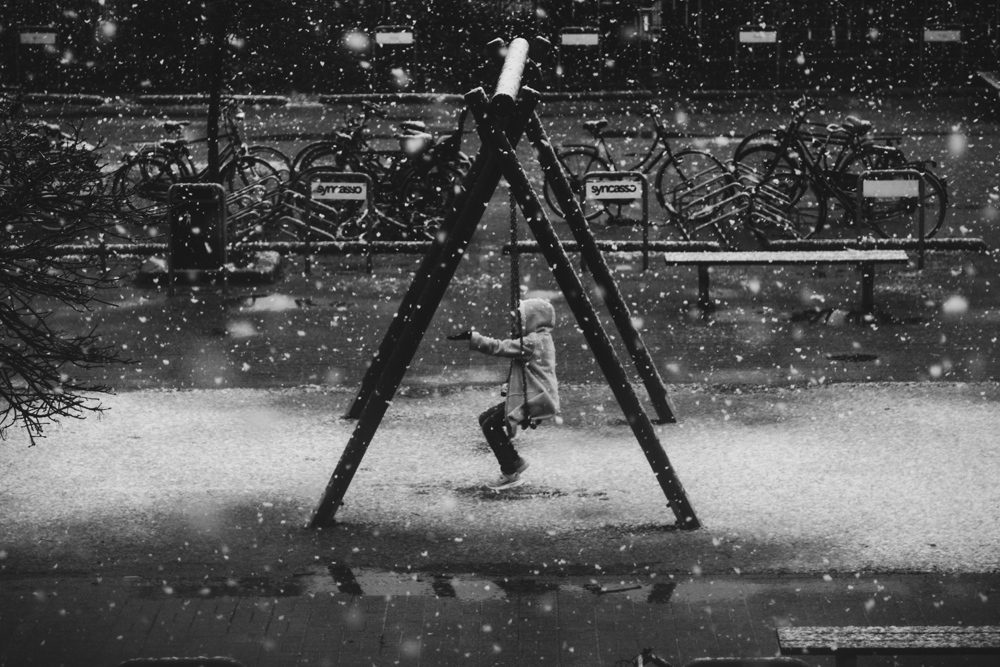
Captured in Utrecht Netherlands, December 2017, this image from Thana Faroq’s book ‘I Don’t Recognize Me in the Shadows’ shows a young girl from a refugee camp experiencing her first snowfall, a moment of wonder amidst the shadows of displacement.
Thana Faroq is a Yemeni photographer, writer, and educator, currently based in the Netherlands. Her artistic practice is primarily focused on capturing the aftermath of pivotal events, especially in the context of migration. Faroq’s work is deeply rooted in themes of women’s resilience, adaptability, and the search for belonging. Through her lens, she provides a poignant exploration of post-disaster homes — spaces that are rich tapestries of loss, hope, memories, and the enduring spirit of those who rebuild and move forward. Faroq’s work serves as a visual autobiography, resonating with topics of memory, migration, and intergenerational trauma. She intertwines text and image, using words not just as a supplementary narrative but as standalone imagery. This approach allows her to explore the profound changes that have shaped her life and sense of belonging, both in her native Yemen and in her adopted home in the Netherlands. Faroq’s recently published her new book “ How shall we greet the sun” which was listed as one of the most beautiful and impressive books of 2023 by NRC Netherlands. Accolades in Faroq’s career include the Open Society Foundation Fellowship Grant in 2018, support from the Arab Documentary Fund backed by the Prince Claus Fund and Magnum Foundation in 2019, recognition as ‘One to Watch’ by the British Journal of Photography in 2020, and the PhotoWien Photo Book Award in 2021 for her book, “I Don’t Recognize Me in the Shadows.
Abdullah
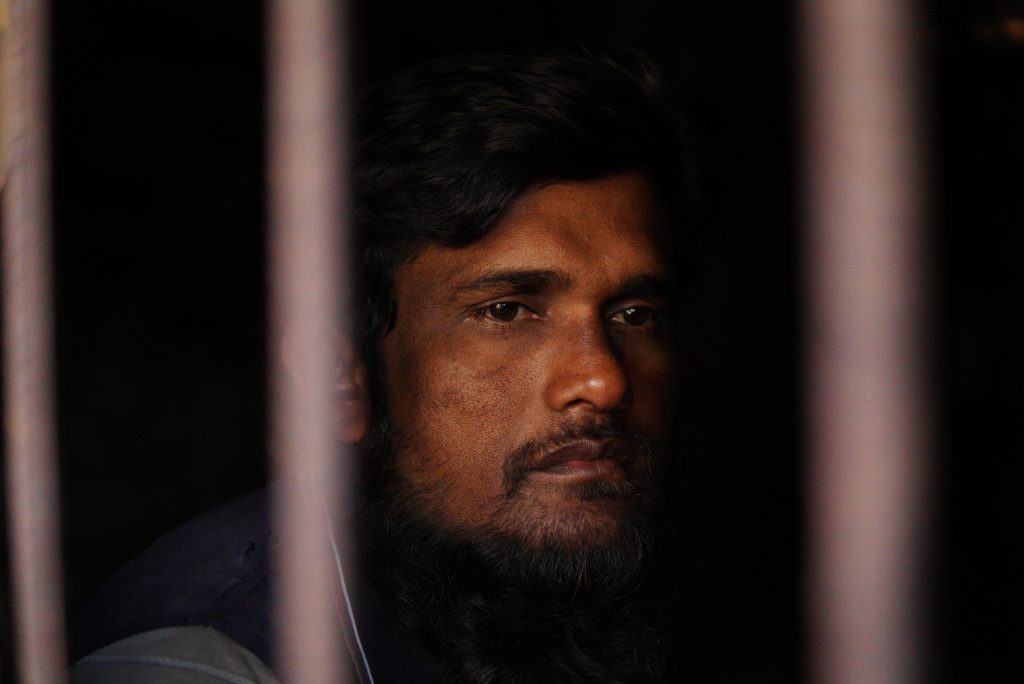
The man in the photo is Mohammad Karim, a 45-year-old Rohingya refugee surviving in the world largest refugee camp. He feels “refugee life is like a bird trapped in the cage. He wants to be released and fly away to live the life in peace”. Rohingya are trapped in the refugee camp for 6 years and live with a hope of returning to their homeland one day. This photo was taken on 28th March 2022 in the Rohingya refugee camp.
Abdullah is a Rohingya artist and storyteller undertaking photography, videography and poetry. He is a former school teacher from Maungdaw, Rakhine State in Myanmar. Forced to flee his home, he arrived in Bangladesh in early September 2017 and started working with the Rollywood Rohingya film team making videos reenacting Rohingya life. He has produced several photo essays and poetry books on different topics. In 2019, his photographs were published by the Asia Time and many others. In August 2020, he received third prize in the photo series category from the Rohingya Photo Competition. In 2021, his work was published by Westword in Today, Tomorrow, Forever: Being Rohingya in Australia. His photographs have been exhibited at the Human Rights Research and Education Centre in Ottawa and the Oxford Human Rights Festival. In 2022, He and his fellow photographers published a photo magazine on Identity of Rohingya with their collective photos and story. Moreover, he was awarded for his photography and poetry in the International Art Contest on Statelessness organised by Minority Rights Group International, OHCHR, UN and UNHCR in Geneva. In 2023, He represented the stories of his community with his poetry in the 10th edition of Litfest in Dhaka with other two Rohingya female artists and created a couple documentary films, some of them are The Rohingya resistance and human trafficking. Recently, he has been recognised as a Nansen refugee award regional winner for Asia and Pacific.
Bassam Khabieh
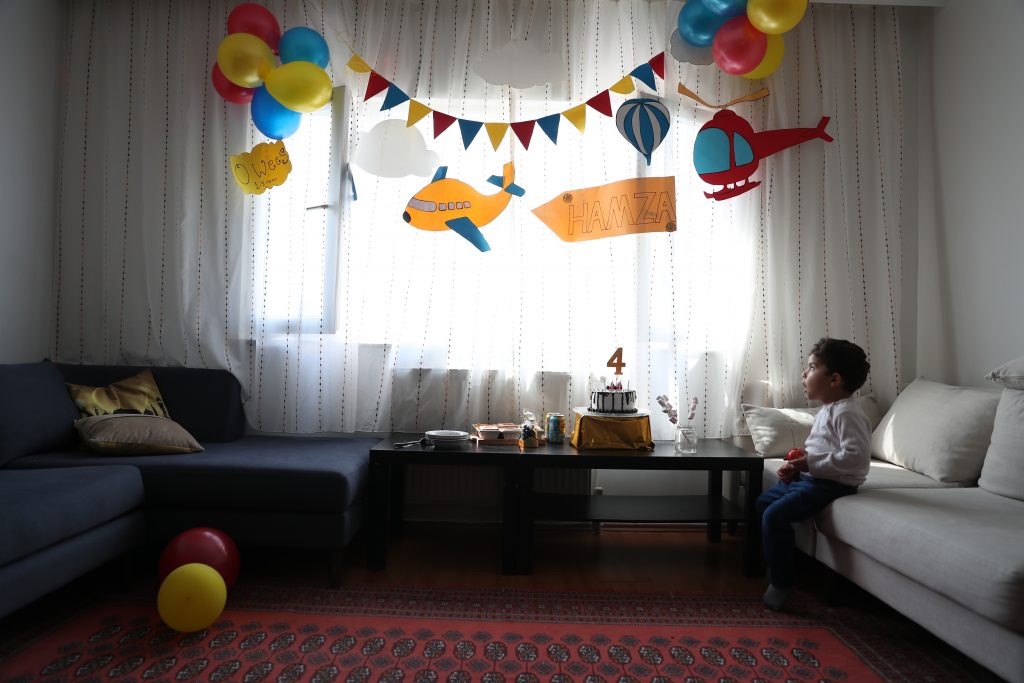
Hamza celebrates his 4th birthday at home due to the COVID-19 lockdown in the Basakshier neighbourhood in Istanbul. Hamza and his family lived under siege for five continuous years and then were forcibly displaced from Eastern Ghouta after a heavy military operation led by Russian and Syrian forces. Hamza feels the changes that come with displacement and asks many difficult questions that are hard to answer for someone his age – questions about his identity, language, and country of origin such as, “When will we go back to Syria? Why did we leave? Why is Syria broken? Are we going to see my grandfather again?”
Bassam Khabieh is a self-taught internationally recognized Syrian photographer who for eight years documented war crimes and other ongoing human rights violations in the Syrian war while working for Reuters and other global publications. He was awarded the Robert Capa Gold Medal in 2015 and named a fellow at the Oak Institute for Human Rights at Colby College in 2018, where he taught photography and human rights. In December 2018, he returned to Turkey after finishing his fellowship, to cover Syrian news and work with a Syrian NGO in archiving and preserving a Syrian archive for future use in legal cases. In March 2022, he moved to Manchester in the United Kingdom in hope to seek a refuge and proceed with his work as photographer and Human Rights Activist.
The copyright of the images is owned by the artists.
Conceived by Vivienne Francis. Assisted by Charlie Evans-Flagg.
Curated by Veronica Otero.
